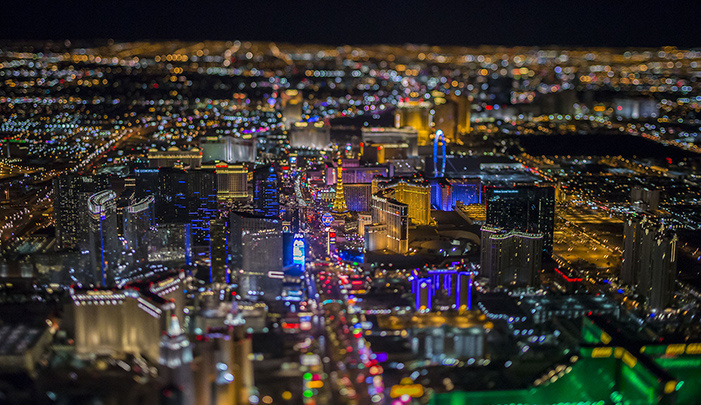I have been following and reporting on Vincent Laforet's "AIR" series since its first round was released. I came across an early printing of the book itself in the waiting area of San Francisco's Storehouse startup while I was about to take on another interview. I knew Storehouse and Laforet had a good working relationship, and I knew the images so well. But I didn't have time to look inside -- not that I felt I had to, however, since I knew the work inside and out. So when Laforet offered me a copy of the book to review, I simply had to say, "Of course," even if it was with mixed feelings. What could I, objectively speaking, really get out of it? Hadn't I seen it all?
If you, as many, have been following the series of images released online from Laforet's ten-city tour, you're equally familiar as I am with the highly saturated, neon turquoise-teals and street-light yellows of the busy cityscapes photographed from heights rarely seen from a helicopter. While stunning at first, they can also be overwhelming. And the cover of "AIR," though iconic, doesn't suggest anything different lies within. Yet, to my great and pleasant surprise, I was greeted with plenty that was new to me.
Naturally, I expected to come across a hundred or so of Laforet's equally dark and bright, birds-eye expanses lit only with artificial sources our society turns on every night. But opening the book reveals huge, beautiful expanses of the most recognizable city from the air: New York, New York.
After a blood red sunset over Manhattan comes a slightly less conventional expanse over Central Park at a magical time, out from which extends all of midtown and downtown, exposing New Jersey to the right and Brooklyn to the left under dark, ominously covered sky. Views of Barcelona dive deeper into dozens of perfectly organized fortress-like blocks lined up and down in grids, separated later in another image only by the city's towering cathedral overshadowing the still-long shadows cast by a late sunset upon old-world European architecture. Miami beaches bask in a post-sunset grey, cooled off by white sands under the coming indigo night with the ocean still Carribbean-blue as ever. These are some of the least expected scenes in the book.

A variety of image types, including some tilt-shift images, help break up the birds-eye views with new perspectives throughout the book.
Not all cities are so surprising. Las Vegas, for instance, gets no daylight treatment. But would it deserve one? In all, "AIR" makes sense -- a lot more than I thought it might. The photographs that make up the distinctive look seen online in pre-released images are still found in abundance throughout, as they should be. But as soon as they grow somewhat tired in the moment, a new vista emerges at the edges of the next turning page -- something to delight you. And then, a shift in perspective returns you to the familiar nightscape, but each time in a slightly new way.
Practically speaking, the book is large -- about the largest it could be while still being relatively comfortable to hold. But this it needed: its large pages in order to allow the viewer to soak deep within the facets of every city scene, and the still-holdable size with which to bring it up to the eye when something in particular truly intrigues. When you have more time, a generous introduction and several pages to help close the book shed light on behind-the-scenes and other relevant information about the project.
Thankfully, as far as you can enjoy these images for their depth, they're also easily digestible which (not to be rude, but again, to be practical) makes them something to consider putting upon the coffee table and not just up on the bookshelf: guests of all backgrounds and with varying interests will find it easy to marvel at the images herein.

San Francisco's city grid is interrupted up by several diagonal streets, one of which leads straight to its iconic Transamerica Pyramid building.
At $59.95, the book isn't cheap, but when you feel its weight and (forgetting even, for a moment, the actual value of the work) when you see the sheer number of images within its 228 pages, you'll wonder how you didn't pay more. Meanwhile, an autographed copy of "AIR" is also available for $99.95.







